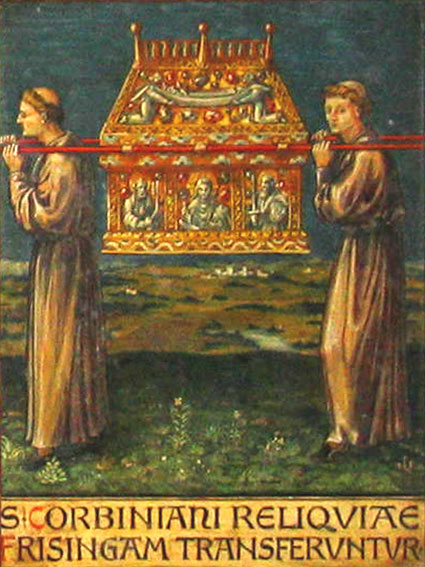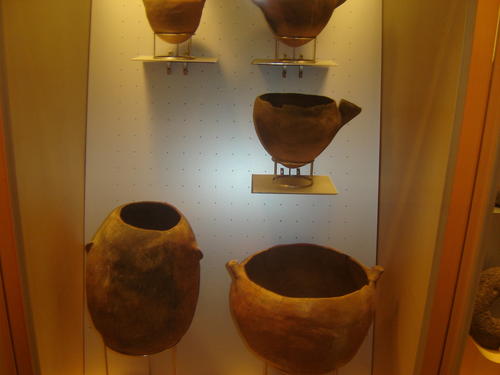|
Cave Of Achbinico
Cueva de Achbinico, also called cave of San Blas () is a Roman Catholic church and cave located in Candelaria, Tenerife, Canary Islands (Spain). After the conquest of the Canary Islands it was the first Christian sanctuary of religious significance. It was also the first sanctuary dedicated to the Virgin Mary in the Canary Islands, where the Virgin of Candelaria, the patron saint of the Canary islands, was worshipped. Situation and presentation The cave is located on the coast, just behind the basilica of Our Lady of Candelaria. It is elongated and deep, with a ceiling shaped as a dome. It is 14 meters long by 6 meters wide and 5 meters high. A small chapel was built just outside of it, covering and including within its walls the entrance of the cave. Inside the cave is a bronze replica of the Virgin of Candelaria. Her statue is most venerated on the island, and has turned the cave into the most important pilgrimage centre in the Canaries for the past five centuries. It ... [...More Info...] [...Related Items...] OR: [Wikipedia] [Google] [Baidu] [Amazon] |
Candelaria, Tenerife
Candelaria, also Villa Mariana de Candelaria, is a municipality and city in the eastern part of the island of Tenerife in the Province of Santa Cruz de Tenerife, in the Canary Islands, Spain. The city is located on the coast, 17 km southwest of Santa Cruz de Tenerife. The population is 25,140 (2010), and the area is 49.18 km². The town is noted by Catholics in Spain and Latin America as a place of veneration of the Virgin of Candelaria, the patron of the Canary Islands. The most prominent building is the Basilica of Candelaria, which holds the sculpture of the Virgin Mary and murals. Also highlighted on the square are statues of the nine aboriginal kings of Tenerife. In the times of the historic Guanche, the region was part of the ''menceyato'', or kingdom, of Güímar. A sacred cave is situated near Candelaria that is believed to have been a place of indigenous worship for more than 3,000 years. Since 1995 the ''Festival de la Canción de Candelaria'' has become ... [...More Info...] [...Related Items...] OR: [Wikipedia] [Google] [Baidu] [Amazon] |
Basilica Of Candelaria
The Basilica of the Royal Marian Shrine of Our Lady of Candelaria ( or simply ''Basílica de la Candelaria'') is a Roman Catholic minor basilica, the first Marian shrine of the Canary Islands,Artículo periodístico de ''El Día'' . located in the municipality and city of Candelaria on the island of (, |
Alonso Fernandez De Lugo
Alonso is a Spanish name of Germanic origin that is a Castilian variant of ''Adalfuns''. The original Visigothic name ''Alfonso'' suffered the phonetic change of the phoneme /f/ into the mute /h/ in the Early Middle Ages (around 9th Century), what eventually suppressed the sound /f/ from the name, deriving in the modern form ''Alonso''. Due to the demographic particularities of the Iberian peninsula during the Middle Ages, this phonetic change was not uniform across the territory and the original form ''Alfonso'' also survived in different areas. Therefore, today both forms of the name coexist in Spanish speaking countries. Geographical distribution As of 2014, 36.6% of all known bearers of the surname ''Alonso'' were residents of Spain (frequency 1:222), 26.1% of Mexico (1:832), 8.3% of Cuba (1:242), 7.0% of Argentina (1:1,061), 4.8% of Brazil (1:7,502), 4.5% of the United States (1:14,083), 2.5% of Colombia (1:3,318), 1.7% of Paraguay (1:736), 1.3% of France (1:9,082) and 1.1 ... [...More Info...] [...Related Items...] OR: [Wikipedia] [Google] [Baidu] [Amazon] |
Camarín
A camarín is a shrine or chapel set above and behind the altar in a church, but still visible from the body of the church. They are especially found in Spain and Portugal and throughout Latin America Latin America is the cultural region of the Americas where Romance languages are predominantly spoken, primarily Spanish language, Spanish and Portuguese language, Portuguese. Latin America is defined according to cultural identity, not geogr .... George Kubler and Martin Soria, in ''Art and Architecture of Spain and Portugal'', trace the typology to the mid-15th century Aragonese "viril", a window in the high altar created to display the consecrated host. According to Kubler and Soria, the camarín is first utilized in the Basílica de la Virgen de los Desamparados (Valencia), designed by Diego Martinez Ponce de Urrana 1652–1657. In de Uranna's design, one passes from the oval nave through one of two doorways flanking the high altar. These open on to chambers, at the rear ... [...More Info...] [...Related Items...] OR: [Wikipedia] [Google] [Baidu] [Amazon] |
Our Lady Of Candelaria
The Virgin of Candelaria or Our Lady of Candelaria ( or ''Nuestra Señora de la Candelaria'') (), popularly called ''La Morenita'', celebrates the Virgin Mary on the island of Tenerife, one of the Canary Islands (Spain). The center of worship is located in the city of Candelaria in Tenerife. She is depicted as a Black Madonna. The "Royal Basilica Marian Shrine of Our Lady of Candelaria" (Basilica of Candelaria) is considered the main church dedicated to the Virgin Mary in the Canary Islands and she is the patroness saint of the Canary Islands. Her feast is celebrated on February 2 (Fiesta de la Candelaria) and August 15, the patronal feast of the Canary Islands. Her devotion is deeply rooted in other parts of Spain, and in countries such as Bolivia, Colombia, Cuba, Philippines, Mexico, Peru, Venezuela and others. Her patronage also extends to various cities and countries in America and other continents. This has made the Virgin of Candelaria the second most widespread Marian devo ... [...More Info...] [...Related Items...] OR: [Wikipedia] [Google] [Baidu] [Amazon] |
Translation (relic)
In Christianity, the translation of relics is the ceremonial removal of holy objects from one place to another (usually a higher-status location). Usually only the movement of the remains of a saint's body would be treated so formally, with secondary relics such as items of clothing treated with less ceremony. Translations could be accompanied by many acts, including all-night vigils and processions, often involving entire communities. The solemn translation (in Latin, ) of relics is not treated as the outward recognition of sanctity. Rather, miracles confirmed a saint's sanctity, as evinced by the fact that when the papacy attempted to make canonization an official process in the twelfth century, many collections of miracles were written in the hope of providing proof of the saint-in-question's status. In the early Middle Ages, the solemn translation marked the moment at which, the saint's miracles having been recognized, the relic was moved by a bishop or abbot to a prominent po ... [...More Info...] [...Related Items...] OR: [Wikipedia] [Google] [Baidu] [Amazon] |
Cave Of Chinguaro
Cave-Shrine of Chinguaro is a cave and associated Roman Catholic church located in Güímar on Tenerife (Canary Islands, Spain). It was the traditional palace of Acaimo, the Guanche king of the Menceyato de Güímar. After the Spanish conquest, they venerated the cave as a site of the Virgin Mary, and later built a church shrine there. In this cave, the ancient Guanche venerated the goddess Chaxiraxi of their traditional faith, related to the Berbers of North Africa. After the Castillian conquest, Spanish clergy identified the icon with the Virgin Mary and had it moved to the Cave of Achbinico in Candelaria. This cave became the first shrine devoted to the Virgin of Candelaria. It was the first Guanche shrine to contain a Christian idol in the Canary Islands, but most of the natives adhered to their traditional religion. The cave has been found to be a site of archaeological importance. Layers of ash have been carbon-dated and found to be more than 3,000 years old, show ... [...More Info...] [...Related Items...] OR: [Wikipedia] [Google] [Baidu] [Amazon] |
Mencey
The Guanche were the Indigenous peoples, indigenous inhabitants of the Spain, Spanish Canary Islands, located in the Atlantic Ocean some to the west of modern Morocco and the North African coast. The islanders spoke the Guanche language, which is believed to have been related to the Berber languages of mainland North Africa; the language became extinct in the 17th century, soon after the islands were colonized. It is believed that the Guanche may have arrived at the archipelago some time in the 1st millennium BC, first millennium BC. The Guanche were the only indigenous people known to have lived in the Macaronesian archipelago region before the arrival of Europeans. There is no accepted evidence that the other Macaronesian archipelagos (the Cape Verde Islands, Madeira and the Azores) were inhabited. After the commencement of the Conquest of the Canary Islands, Spanish conquest of the Canaries, starting in the early 15th century, many natives were outright killed by the Spanish ... [...More Info...] [...Related Items...] OR: [Wikipedia] [Google] [Baidu] [Amazon] |
Acaymo
Acaimo or Acaymo was a Guanche ''mencey'' of Tacoronte, on the island of Tenerife at the time of the Spanish conquest in the 15th century. He formed an alliance against the Spaniards with the ''mencey'' Beneharo and the ''mencey'' Bencomo. Biography Family and Descendancy Acaimo descended from the first ''mencey'' of Tacoronte, who was called "Rumén" or "Romén" by Juan Núñez de la Peña. During the division of the island, which occurred after the death of his father, Tinerfe the Great, in the late fourteenth century, Acaimo took his father's territory. However, the scholar Juan Álvarez Delgado says that Aniaga is the parent of Acaimo, and Acaimo's full name is Acaimo ''Daniaga''. From Peña, Aniaga married a sister of Acaimo de Güímar, and because of this, she gave another name to her son. On the other hand, Viana also mentioned another son of the ''mencey'', whose name was Badenol, who died in the second Acentejo battle. She referred to Acaimo de Tacoronte as a ... [...More Info...] [...Related Items...] OR: [Wikipedia] [Google] [Baidu] [Amazon] |
Guanches
The Guanche were the Indigenous peoples, indigenous inhabitants of the Spain, Spanish Canary Islands, located in the Atlantic Ocean some to the west of modern Morocco and the North African coast. The islanders spoke the Guanche language, which is believed to have been related to the Berber languages of mainland North Africa; the language became extinct in the 17th century, soon after the islands were colonized. It is believed that the Guanche may have arrived at the archipelago some time in the 1st millennium BC, first millennium BC. The Guanche were the only indigenous people known to have lived in the Macaronesian archipelago region before the arrival of Europeans. There is no accepted evidence that the other Macaronesian archipelagos (the Cape Verde Islands, Madeira and the Azores) were inhabited. After the commencement of the Conquest of the Canary Islands, Spanish conquest of the Canaries, starting in the early 15th century, many natives were outright killed by the Spanish ... [...More Info...] [...Related Items...] OR: [Wikipedia] [Google] [Baidu] [Amazon] |
Kingdom Of Castile
The Kingdom of Castile (; : ) was a polity in the Iberian Peninsula during the Middle Ages. It traces its origins to the 9th-century County of Castile (, ), as an eastern frontier lordship of the Kingdom of León. During the 10th century, the Castilian counts increased their autonomy, but it was not until 1065 that it was separated from the Kingdom of León and became a kingdom in its own right. Between 1072 and 1157, it was again united with León, and after 1230, the union became permanent. Throughout that period, the Castilian kings made extensive conquests in southern Iberia at the expense of the Islamic principalities. The Kingdoms of Castile and of León, with their southern acquisitions, came to be known collectively as the Crown of Castile, a term that also came to encompass overseas expansion. History 9th to 11th centuries: beginnings According to the chronicles of Alfonso III of Asturias, the first reference to the name "Castile" (Castilla) can be found in a documen ... [...More Info...] [...Related Items...] OR: [Wikipedia] [Google] [Baidu] [Amazon] |




